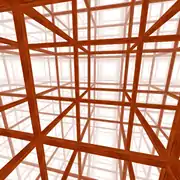Cubic honeycomb honeycomb
In the geometry of hyperbolic 4-space, the cubic honeycomb honeycomb is one of two paracompact regular space-filling tessellations (or honeycombs). It is called paracompact because it has infinite facets, whose vertices exist on 3-horospheres and converge to a single ideal point at infinity. With Schläfli symbol {4,3,4,3}, it has three cubic honeycombs around each face, and with a {3,4,3} vertex figure. It is dual to the order-4 24-cell honeycomb.
| Cubic honeycomb honeycomb | |
|---|---|
| (No image) | |
| Type | Hyperbolic regular honeycomb |
| Schläfli symbol | {4,3,4,3} {4,31,1,1} |
| Coxeter diagram | |
| 4-faces |  {4,3,4} {4,3,4} |
| Cells | |
| Faces | |
| Face figure | |
| Edge figure | |
| Vertex figure | |
| Dual | Order-4 24-cell honeycomb |
| Coxeter group | R4, [4,3,4,3] |
| Properties | Regular |
Related honeycombs
It is related to the Euclidean 4-space 16-cell honeycomb, {3,3,4,3}, which also has a 24-cell vertex figure.
It is analogous to the paracompact tesseractic honeycomb honeycomb, {4,3,3,4,3}, in 5-dimensional hyperbolic space, square tiling honeycomb, {4,4,3}, in 3-dimensional hyperbolic space, and the order-3 apeirogonal tiling, {∞,3} of 2-dimensional hyperbolic space, each with hypercube honeycomb facets.
See also
References
- Coxeter, Regular Polytopes, 3rd. ed., Dover Publications, 1973. ISBN 0-486-61480-8. (Tables I and II: Regular polytopes and honeycombs, pp. 294–296)
- Coxeter, The Beauty of Geometry: Twelve Essays, Dover Publications, 1999 ISBN 0-486-40919-8 (Chapter 10: Regular honeycombs in hyperbolic space, Summary tables II,III,IV,V, p212-213)